A Review on the Usage of Continuous Carbon Fibers for Piezoresistive Self Strain Sensing Fiber Reinforced Plastics
Abstract
:1. Introduction
- The simplest level of complexity we analyze in this work is that of a single carbon fiber filament under uniaxial strain. Numerous experiments were conducted that analyze the change of electrical resistance of single carbon fibers due to mechanical strain.
- The next step in complexity arises by adding a polymer matrix to the fiber.
- The complexity of the system is larger when multiple filaments are embedded into a polymer matrix in the form of a roving.
- Multiple rovings form a ply of carbon fiber. The current is then distributed between significantly more filaments.
- The last step of complexity regarded in this article is that of a larger carbon fiber laminate consisting of multiple plies. Different layer orientation and resin rich interfaces can change the behavior of these parts when compared to single plies.
2. Definitions and Mathematics of Strain Sensing
3. Practical Implementations of Resistance Measurements
3.1. Electrical Test Setups
3.2. Contacting Carbon Fiber Laminates
- Silver filled epoxies from various manufacturers. These epoxies form a mechanically durable bond with a relatively large conductivity(e.g., used in [21])
- Silver paint. Instead of epoxy, an organic binder with large concentration of solvent is used here. While the conductivity is similar to silver epoxies, the connection is not as mechanically durable (e.g., used in [22])
- Graphite cement. Graphite dust can be used instead of silver to generate conductivity. A popular binder material for low-cost applications is polyvenylacetat (PVA). The conductivity is generally lower than products based on silver (e.g., used in [21])
4. Resistance Change of Single Carbon Fibers due to Mechanical Strain
4.1. Examinations of Single Bare Carbon Fibers under Tensile Load
4.2. Examinations on Single Carbon Fibers Embedded into Polymer
5. Embedding Carbon Fiber Rovings into a Polymer for Strain Sensing
| Manufacturer | Fiber Name | Fila-Ment Count | Connection | Method | Gauge Factor | Source |
|---|---|---|---|---|---|---|
| Toray | T300 | 1 k | galvanic deposition | WB | 1.71 | [45] |
| Toho Tenax | HTA40 | 3 K | wound wire | WB | 1.3 | [46] |
| Toray | T700SC | 12 k | silver paint | WB | 2 | [47] |
| Toho Tenax | HTA40 | 1 k | clamped | WB | 1.72 | [48] |
| Toho Tenax | T300B | 1 k | clamped | WB | 1.54 | [48] |
| Nippon | PAN based | 6 k | silver paint | WB | 2.85–3.36 | [22] |
| Toray | T700SC | ? | ? | WB | 4–5 | [49,50] |
| unspecified | PAN based | 24 k | silver adhesive | WB | 1.35 | [51] |
| Toho Tenax | HM35 | 35 | carbon cement | 2-wire | 1.96–2.17 | [52] |
| Toho Tenax | T300B | 3 k | silver adhesive | 2-wire | 1.5 | [53] |
6. Using large Carbon Fiber Reinforced Plastic Structures as Strain Sensors
6.1. Longitudinal Resistance Change with Longitudinal Strain

| Manufacturing | Material | Thickness/mm | Connection | Method | Gauge Factor | Source |
|---|---|---|---|---|---|---|
| prepreg compression moulded | T300/Hy-E1076E | 1.4 | silver paste | 4-wire | −35–−38 | [2] |
| prepreg compression moulded | T300/Hy-E1076E | 1.1 | silver paste | 4-wire | −23 | [59] |
| prepreg compression moulded | T300/Hy-E1076E | 1.1 | silver paste | 2-wire | 3 | [59] |
| prepreg compression moulded | T300/Hy-E1076E | 1.1 | silver paste | 4-wire | −4.6 | [59] |
| prepreg compression moulded | T300/Hy-E1076E | 1.1 | silver paste | 2-wire | 8.6 | [59] |
| prepreg hotpress | Q111/2500 | 0.25 | silver paste | 4-wire | 2 | [62] |
| prepreg hotpress | Q111/2500 | 1.5 | silver paste polished | 4-wire | 2.6 | [62] |
| prepreg hotpress | Q111/2500 | 1.5 | silver paste unpolished | 4-wire | −20 | [62] |
| prepreg autoclave | T300/914 | 2 | silver epoxy | 4-wire | 3.6 | [63] |
| prepreg autoclave | T300/914 | 2 | silver paint | 4-wire | 20.6 | [63] |
| prepreg autoclave | T300/914 | 2 | carbon cement | 4-wire | −89 | [63] |
| prepreg autoclave | T300/914 | 2 | sputtered chromium | 4-wire | 1.75 | [21] |
| prepreg | Fortafil 555/C2002 | 0.15 | silver paint | 4-wire | 1.8–3.5 | [61] |
| prepreg | Fortafil 555/C2002 | 0.31 | silver paint | 4-wire | −6 | [61] |
| prepreg vacuum pressure | TR30S/ Pyrofil380 | 0.23 | copper plating | 4-wire | 2.35 | [64] |
| vacuum press method | T300/HZ9901 | 7 | silver paint | 2-wire | 2.7 to 3.5 | [65] |
| brush application | T300/HZ9901 | 7 | silver paint | 2-wire | 22 to 28 | [65] |
| prepreg autoclave | PYLOFIL 380 | 0.22 | copper electrodeposition | 4-wire | 1.5–2.2 | [66] |
- Other explanations invole the interply region of a multy ply laminate [61].
- Lastly, it has been hypothesized that the change of both longitudinal and transverse resistivity and its interaction with the potential distribution in the cross section can lead to negative gauge factors [66]. It is important to note that this negative gauge factor is measured even though the longitudinal resistance of the fibers grows during straining. The decrease of resistance is not due to a decrease in longitudinal resistance, but results from a change of potential distribution due to the difference in longitudinal and transverse gauge factor. This explanation could therefor explain both the consistently positive gauge factor of roving experiments as well as deviating results from laminate experiments.
6.2. Transverse and through Thickness Resistance Change Due to Longitudinal Strain
7. Summary, Conclusions and Outlook
- Analyze the electrical and Self Sensing properties of the conductive carbon fiber used in your study with single fiber measurements. Insufficient knowledge of the piezoresistive behavior of the carbon fiber used complicates the interpretation of measurements on more complex structures.
- Discuss the current homogeneity of your experimental setup. A good estimation technique is to calculate the rule of mixture resistivity and compare it to the experimentally acquired resistivity. Depending on whether the current density at the points of voltage measurement is larger or smaller than for uniform current conditions, the measured resistivity can also be larger or smaller than the estimated one. If the estimate and the measurement are not reasonably close to one another, a significant current inhomogeneity is present which will have an impact on the experimentally acquired gauge factors.
- Report on the surface preparation method used before electrically contacting the carbon fibers. We ascertain that it is necessary to remove any resin rich surface layer to generate a homogeneous current introduction throughout the surface. It has been correctly pointed out in the past that surface polishing damages the fibers [4,60]. However, the removal of a resin rich surface is important for the generation of a uniform current. Other surface preparation methods developed in the field of adhesive technologies such as laser ablation could proove to be usefull for further studies. Chemical etching processes have also been used in the past and may be better suited to remove a resin rich surface without damaging the fibers [66,72]. We believe that the development of repeatable surface preparation technologies in conjunction with reliable electrical contact manufacturing will play a critical role in the further development of Self-Sensing structures.
- Report on the resistance change for both the loading and unloading of the sensor to expose potential hysteresis. We suggest loading and unloading the specimen repeatedly multiple times. This allows us to discuss the stability of the sensor during multiple strain cycles. For the analysis of Self-Strain-Sensing properties, the maximum strain should be large enough to obtain results for typical strains occurring in practical applications, but not so large as to result in irreversible damage. We suggest a maximum strain between 0.3% and 0.5%. Additionally, discuss the linearity of the resistance change with strain. Lastly, report the repeatability of the experiment for multiple specimens fabricated with the same identical manufacturing process.
Funding
Institutional Review Board Statement
Informed Consent Statement
Conflicts of Interest
References
- Yan, W.; Dong, C.; Xiang, Y.; Jiang, S.; Leber, A.; Loke, G.; Xu, W.; Hou, C.; Zhou, S.; Chen, M.; et al. Thermally drawn advanced functional fibers: New frontier of flexible electronics. Mater. Today 2020, 35, 168–194. [Google Scholar] [CrossRef]
- Wang, X.; Chung, D.D.L. Continuous carbon fibre epoxy-matrix composite as a sensor of its own strain. Smart Mater. Struct. 1996, 5, 796. [Google Scholar] [CrossRef]
- Forintos, N.; Czigany, T. Reinforcing carbon fibers as sensors: The effect of temperature and humidity. Compos. Part A Appl. Sci. Manuf. 2020, 131, 105819. [Google Scholar] [CrossRef]
- Park, J.B.; Okabe, T.; Takeda, N. New concept for modeling the electromechanical behavior of unidirectional carbon-fiber-reinforced plastic under tensile loading. Smart Mater. Struct. 2003, 12, 105–114. [Google Scholar] [CrossRef]
- Prasse, T.; Michel, F.; Mook, G.; Schulte, K.; Bauhofer, W. A comparative investigation of electrical resistance and acoustic emission during cyclic loading of CFRP laminates. Compos. Sci. Technol. 2001, 61, 831–835. [Google Scholar] [CrossRef]
- Schulte, K. Damage monitoring in polymer matrix structures. Le J. De Phys. IV 1993, 3, C7-1629–C7-1636. [Google Scholar] [CrossRef]
- Abry, J.; Choi, Y.; Chateauminois, A.; Dalloz, B.; Giraud, G.; Salvia, M. In-situ monitoring of damage in CFRP laminates by means of AC and DC measurements. Compos. Sci. Technol. 2001, 61, 855–864. [Google Scholar] [CrossRef]
- Schulte, K.; Baron, C. Load and failure analyses of CFRP laminates by means of electrical resistivity measurements. Compos. Sci. Technol. 1989, 36, 63–76. [Google Scholar] [CrossRef]
- Saifeldeen, M.A.; Fouad, N.; Huang, H.; Wu, Z.S. Health monitoring of bridges based on distributed long gauge carbon fiber sensors. In Proceedings of the 2nd International Conference on Bridge Testing, Monitoring & Assessment, Cairo, Egypt, 27–29 December 2015; pp. 27–29. [Google Scholar]
- Horoschenkoff, A. Use of carbon fiber sensors to determine the deflection of composite-beams. In Proceedings of the ICCM Conference, Jeju Island, Korea, 21–26 August 2011. [Google Scholar]
- DeTeresa, S.J. Piezoresistivity and failure of carbon filaments in axial compression. Carbon 1991, 29, 397–409. [Google Scholar] [CrossRef]
- Górski, M.; Krzywoń, R.; Borodeńko, M. Development of Self-Sensing Textile Strengthening System Based on High-Strength Carbon Fiber. Materials 2018, 11, 2062. [Google Scholar] [CrossRef] [PubMed] [Green Version]
- Chung, D. A review of multifunctional polymer-matrix structural composites. Compos. Part B Eng. 2019, 160, 644–660. [Google Scholar] [CrossRef]
- Chung, D. Carbon materials for structural self-sensing, electromagnetic shielding and thermal interfacing. Carbon 2012, 50, 3342–3353. [Google Scholar] [CrossRef]
- Todoroki, A.; Ueda, M.; Hirano, Y. Strain and Damage Monitoring of CFRP Laminates by Means of Electrical Resistance Measurement. J. Solid Mech. Mater. Eng. 2007, 1, 947–974. [Google Scholar] [CrossRef] [Green Version]
- Bernstein, H. Elektrotechnik/Elektronik für Maschinenbauer; Springer: Wiesbaden, Germany, 2018. [Google Scholar]
- Winter, P.M.; Lanza, G.M.; Wickline, S.A.; Madou, M.; Wang, C.; Deotare, P.B.; Loncar, M.; Yap, Y.K.; Rose, J.; Auffan, M.; et al. Piezoresistivity. In Encyclopedia of Nanotechnology; Bhushan, B., Ed.; Springer: Dordrecht, The Netherlands, 2012; pp. 2111–2117. [Google Scholar] [CrossRef]
- Kaddour, A.S.; Hinton, M.J. Input data for test cases used in benchmarking triaxial failure theories of composites. J. Compos. Mater. 2012, 46, 2295–2312. [Google Scholar] [CrossRef]
- Chung, D.D.L. A critical review of piezoresistivity and its application in electrical-resistance-based strain sensing. J. Mater. Sci. 2020, 55, 15367–15396. [Google Scholar] [CrossRef]
- Chung, D.D. Composite Materials; Springer: London, UK, 2010. [Google Scholar] [CrossRef]
- Angelidis, N. Damage Sensing in CFRP Composites Using Electrical Potential Techniques. Ph.D. Thesis, Cranfield University, Cranfield, UK, 2004. [Google Scholar]
- Yang, C.Q.; Wang, X.L.; Jiao, Y.J.; Ding, Y.L.; Zhang, Y.F.; Wu, Z.S. Linear strain sensing performance of continuous high strength carbon fibre reinforced polymer composites. Compos. Part B Eng. 2016, 102, 86–93. [Google Scholar] [CrossRef]
- Christner, C.; Horoschenkoff, A.; Rapp, H. Longitudinal and transverse strain sensitivity of embedded carbon fibre sensors. J. Compos. Mater. 2012, 47, 155–167. [Google Scholar] [CrossRef]
- Burda, M.; Lekawa-Raus, A.; Gruszczyk, A.; Koziol, K.K.K. Soldering of Carbon Materials Using Transition Metal Rich Alloys. ACS Nano 2015, 9, 8099–8107. [Google Scholar] [CrossRef]
- Zimney, E.J.; Dommett, G.H.B.; Ruoff, R.S.; Dikin, D.A. Correction factors for 4-probe electrical measurements with finite size electrodes and material anisotropy: A finite element study. Meas. Sci. Technol. 2007, 18, 2067–2073. [Google Scholar] [CrossRef] [Green Version]
- Conor, P.C.; Owston, C.N. Electrical Resistance of Single Carbon Fibres. Nature 1969, 223, 1146–1147. [Google Scholar] [CrossRef]
- Berg, C.A.; Cumpston, H.; Rinsky, A. Piezoresistance of graphite fibers. Text. Res. J. 1972, 42, 486–489. [Google Scholar] [CrossRef]
- Crasto, A.; Kim, R.Y. Using carbon fiber piezoresistivity to measure residual stresses in composites. In Proceedings of the American Society for Composites, Madrid, Spain, 12–16 July 1993; pp. 162–173. [Google Scholar]
- Blazewicz, S.; Patalita, B.; Touzain, P. Study of piezoresistance effect in carbon fibers. Carbon 1997, 35, 1613–1618. [Google Scholar] [CrossRef]
- Wang, X.; Fu, X.; Chung, D.D.L. Strain sensing using carbon fiber. J. Mater. Res. 1999, 14, 790–802. [Google Scholar] [CrossRef]
- Park, J.B.; Okabe, T.; Takeda, N.; Curtin, W.A. Electromechanical modeling of unidirectional CFRP composites under tensile loading condition. Compos. Part A Appl. Sci. Manuf. 2002, 33, 267–275. [Google Scholar] [CrossRef]
- Yoshitake, N.; Mitsuru, H. Influence of Elastic Tensile Stress on Electrical Resistivity of Carbon Fiber. Mater. Trans. 2007, 48, 2969–2972. [Google Scholar]
- Mäder, T.; Nestler, D.; Wielage, B. Strain sensing using single carbon fibres. Int. Conf. Compos. Mater. 2011, 18, 21–26. [Google Scholar]
- Oliveira, L.; Hitchcock, D.; Behlow, H.; Podila, R.; Skove, M.J.; Serkiz, S.M.; Rao, A.M. Second- and Third-Order Elastic Constants of Filaments of HexTow® IM7 Carbon Fiber. J. Mater. Eng. Perform. 2014, 23, 685–692. [Google Scholar] [CrossRef]
- Kalashnyk, N.; Faulques, E.; Schjødt-Thomsen, J.; Jensen, L.R.; Rauhe, J.C.M.; Pyrz, R. Strain sensing in single carbon fiber epoxy composites by simultaneous in-situ Raman and piezoresistance measurements. Carbon 2016, 109, 124–130. [Google Scholar] [CrossRef]
- Yao, Y.; Luo, J.; Duan, X.; Liu, T.; Zhang, Y.; Liu, B.; Yu, M. On the piezoresistive behavior of carbon fibers—Cantilever-based testing method and Maxwell-Garnett effective medium theory modeling. Carbon 2019, 141, 283–290. [Google Scholar] [CrossRef]
- Curtis, G.J.; Milne, J.M.; Reynolds, W.N. Non-Hookean Behaviour of Strong Carbon Fibres. Nature 1968, 220, 1024–1025. [Google Scholar] [CrossRef]
- Zobeiry, N.; Poursartip, A. The origins of residual stress and its evaluation in composite materials. In Structural Integrity and Durability of Advanced Composites; Elsevier: Amsterdam, The Netherlands, 2015; pp. 43–72. [Google Scholar] [CrossRef]
- Wang, X.; Chung, D. Electromechanical behavior of carbon fiber. Carbon 1997, 35, 706–709. [Google Scholar] [CrossRef]
- Yoshitake, N.; Hirano, M. Bending stress dependent electrical resistivity of carbon fiber in polymer for health monitoring system. Mater. Trans. 2007, 48, 2735–2738. [Google Scholar]
- Kwon, D.J.; Wang, Z.J.; Choi, J.Y.; Shin, P.S.; DeVries, K.L.; Park, J.M. Interfacial evaluation of carbon fiber/epoxy composites using electrical resistance measurements at room and a cryogenic temperature. Compos. Part A Appl. Sci. Manuf. 2015, 72, 160–166. [Google Scholar] [CrossRef]
- Northolt, M.G.; Veldhuizen, L.H.; Jansen, H. Tensile deformation of carbon fibers and the relationship with the modulus for shear between the basal planes. Carbon 1991, 29, 1267–1279. [Google Scholar] [CrossRef]
- Khebbab, M.; Feliachi, M.; Latreche, M.E.H. Evaluation of electrical transverse conductivity of the unidirectional CFRP. Eur. Phys. J. Appl. Phys. 2016, 73, 10402. [Google Scholar] [CrossRef]
- Wasselynck, G.; Trichet, D.; Fouladgar, J. Determination of the Electrical Conductivity Tensor of a CFRP Composite Using a 3-D Percolation Model. IEEE Trans. Magn. 2013, 49, 1825–1828. [Google Scholar] [CrossRef]
- Horoschenkoff, A.; Müller, T.; Kröll, A. On the characterization of the piezoresistivity of embedded carbon fibres. In Proceedings of the ICCM Conferences, Edinburgh, Scotland, 27–31 July 2009. [Google Scholar]
- Kunadt, A.; Starke, E.; Pfeifer, G.; Cherif, C. Messtechnische Eigenschaften von Dehnungssensoren aus Kohlenstoff-Filamentgarn in einem VerbundwerkstoffMeasuring Performance of Carbon Filament Yarn Strain Sensors Embedded in a Composite. Tm Tech. Mess. 2010, 77, 113–120. [Google Scholar] [CrossRef]
- Huang, H.; Yang, C.; Wu, Z. Electrical sensing properties of carbon fiber reinforced plastic strips for detecting low-level strains. Smart Mater. Struct. 2012, 21, 035013. [Google Scholar] [CrossRef]
- Häntzsche, E.; Matthes, A.; Nocke, A.; Cherif, C. Characteristics of carbon fiber based strain sensors for structural-health monitoring of textile-reinforced thermoplastic composites depending on the textile technological integration process. Sens. Actuators A Phys. 2013, 203, 189–203. [Google Scholar] [CrossRef]
- Saifeldeen, M.A.; Fouad, N.; Huang, H.; Wu, Z. Advancement of long-gauge carbon fiber line sensors for strain measurements in structures. J. Intell. Mater. Syst. Struct. 2016, 28, 878–887. [Google Scholar] [CrossRef]
- Saifeldeen, M.A.; Fouad, N.; Huang, H.; Wu, Z.S. Stabilization of electrical sensing properties of carbon fiber sensors using pre-tensioning approach. Smart Mater. Struct. 2017, 26, 015012. [Google Scholar] [CrossRef]
- Quadflieg, T.; Stolyarov, O.; Gries, T. Carbon rovings as strain sensors for structural health monitoring of engineering materials and structures. J. Strain Anal. Eng. Des. 2016, 51, 482–492. [Google Scholar] [CrossRef]
- Kalashnyk, N.; Faulques, E.; Schjødt-Thomsen, J.; Jensen, L.R.; Rauhe, J.C.M.; Pyrz, R. Monitoring self-sensing damage of multiple carbon fiber composites using piezoresistivity. Synth. Met. 2017, 224, 56–62. [Google Scholar] [CrossRef]
- Luan, C.; Yao, X.; Shen, H.; Fu, J. Self-Sensing of Position-Related Loads in Continuous Carbon Fibers-Embedded 3D-Printed Polymer Structures Using Electrical Resistance Measurement. Sensors 2018, 18, 994. [Google Scholar] [CrossRef] [PubMed] [Green Version]
- Horoschenkoff, A.; Christner, C. Carbon Fibre Sensor: Theory and Application. In Composites and Their Applications; Hu, N., Ed.; InTech: Rijeka, Croatia, 2012. [Google Scholar] [CrossRef] [Green Version]
- Kunadt, A.; Heinig, A.; Starke, E.; Pfeifer, G.; Cherif, C.; Fischer, W.J. Design and properties of a sensor network embedded in thin fiber-reinforced composites. In Proceedings of the SENSORS, 2010 IEEE, Waikoloa, HI, USA, 1–4 November 2010; pp. 673–677. [Google Scholar] [CrossRef]
- Huang, H.; Wu, Z.S. Static and dynamic measurement of low-level strains with carbon fibers. Sens. Actuators A Phys. 2012, 183, 140–147. [Google Scholar] [CrossRef]
- Mostafa, N.H.; Ismarrubie, Z.N.; Sapuan, S.M.; Sultan, M.T. Fibre prestressed polymer-matrix composites: A review. J. Compos. Mater. 2017, 51, 39–66. [Google Scholar] [CrossRef]
- Höhne, R.; Ehrig, T.; Kostka, P.; Modler, N. Phenomenological investigation of a carbon fibre based strain sensor with spatial resolution by means of time domain reflectometry. Mater. Und Werkst. 2016, 47, 1024–1033. [Google Scholar] [CrossRef]
- Wang, S.; Chung, D.D.L. Piezoresistivity in continuous carbon fiber polymer-matrix composite. Polym. Compos. 2000, 21, 13–19. [Google Scholar] [CrossRef]
- Wang, S.; Chung, D.D.L. Negative piezoresistivity in continuous carbon fiber epoxy-matrix composite. J. Mater. Sci. 2007, 42, 4987–4995. [Google Scholar] [CrossRef]
- Gordon, D.A.; Wang, S.; Chung, D.D.L. Piezoresistivity in unidirectional continuous carbon fiber polymer-matrix composites: Single-lamina composite versus two-lamina composite. Compos. Interfaces 2004, 11, 95–103. [Google Scholar] [CrossRef]
- Todoroki, A.; YOSHIDA, J. Electrical Resistance Change of Unidirectional CFRP Due to Applied Load. JSME Int. J. Ser. A 2004, 47, 357–364. [Google Scholar] [CrossRef] [Green Version]
- Angelidis, N.; Wei, C.Y.; Irving, P.E. The electrical resistance response of continuous carbon fibre composite laminates to mechanical strain. Compos. Part A Appl. Sci. Manuf. 2004, 35, 1135–1147. [Google Scholar] [CrossRef]
- Todoroki, A.; Samejima, Y.; Hirano, Y.; Matsuzaki, R. Piezoresistivity of unidirectional carbon/epoxy composites for multiaxial loading. Compos. Sci. Technol. 2009, 69, 1841–1846. [Google Scholar] [CrossRef]
- Yin, J.; Liu, R.g.; Huang, J.j.; Liang, G.; Liu, D.; Xie, G.h. Comparative study on piezoresistive properties of CFRP tendons prepared by two different methods. Compos. Part B Eng. 2017, 129, 124–132. [Google Scholar] [CrossRef]
- Ueda, M.; Yamaguchi, T.; Ohno, T.; Kato, Y.; Nishimura, T. FEM-aided identification of gauge factors of unidirectional CFRP through multi-point potential measurements. Adv. Compos. Mater. 2019, 28, 37–55. [Google Scholar] [CrossRef]
- Chung, D.D.L.; Wang, S. Discussion on paper ‘The electrical resistance response of continuous carbon fibre composite laminates to mechanical strain’ by N. Angelidis, CY Wei and PE Irving. Compos. Part A Appl. Sci. Manuf. 2006, 37, 1490–1494. [Google Scholar] [CrossRef]
- Angelidis, N.; Wei, C.Y.; Irving, P.E. Response to discussion of paper: The electrical resistance response of continuous carbon fibre composite laminates to mechanical strain. Compos. Part A Appl. Sci. Manuf. 2006, 37, 1495–1499. [Google Scholar] [CrossRef]
- Todoroki, A.; Yoshida, J. Apparent Negative Piezoresistivity of Single-Ply CFRP due to Poor Electrical Contact of Four-Probe Method. Key Eng. Mater. 2005, 297–300, 610–615. [Google Scholar] [CrossRef]
- Ogi, K.; Takao, Y. Characterization of piezoresistance behavior in a CFRP unidirectional laminate. Compos. Sci. Technol. 2005, 65, 231–239. [Google Scholar] [CrossRef]
- Gillet, A.; Olivier, P. Prédiction des propriétés électrique d’un composite aéronautique. In Proceedings of the JNC16, Toulouse, France, 10–12 June 2009. [Google Scholar]
- Todoroki, A.; Suzuki, K.; Mizutani, Y.; Matsuzaki, R. Durability Estimates of Copper Plated Electrodes for Self-sensing CFRP Composites. J. Solid Mech. Mater. Eng. 2010, 4, 610–620. [Google Scholar] [CrossRef] [Green Version]
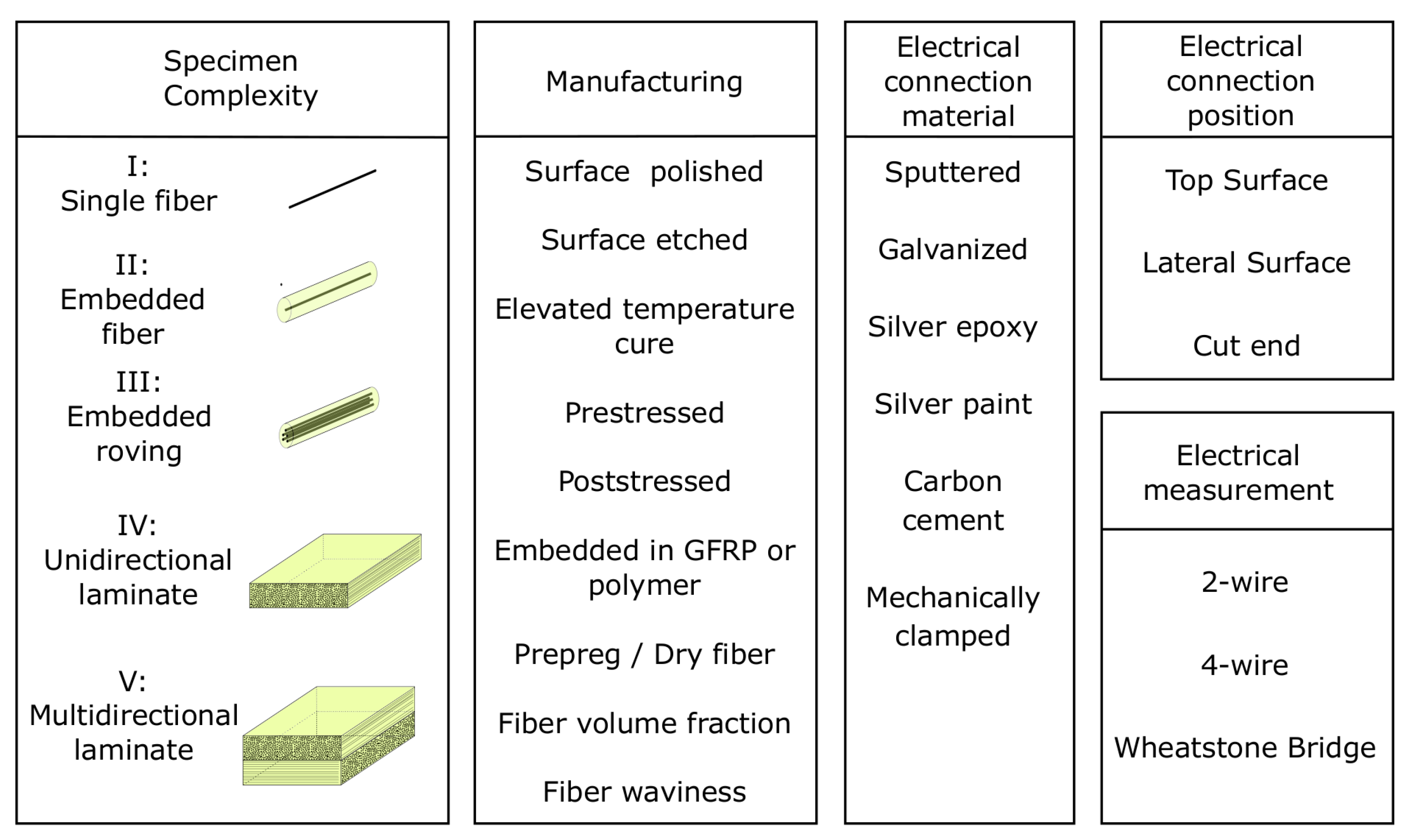
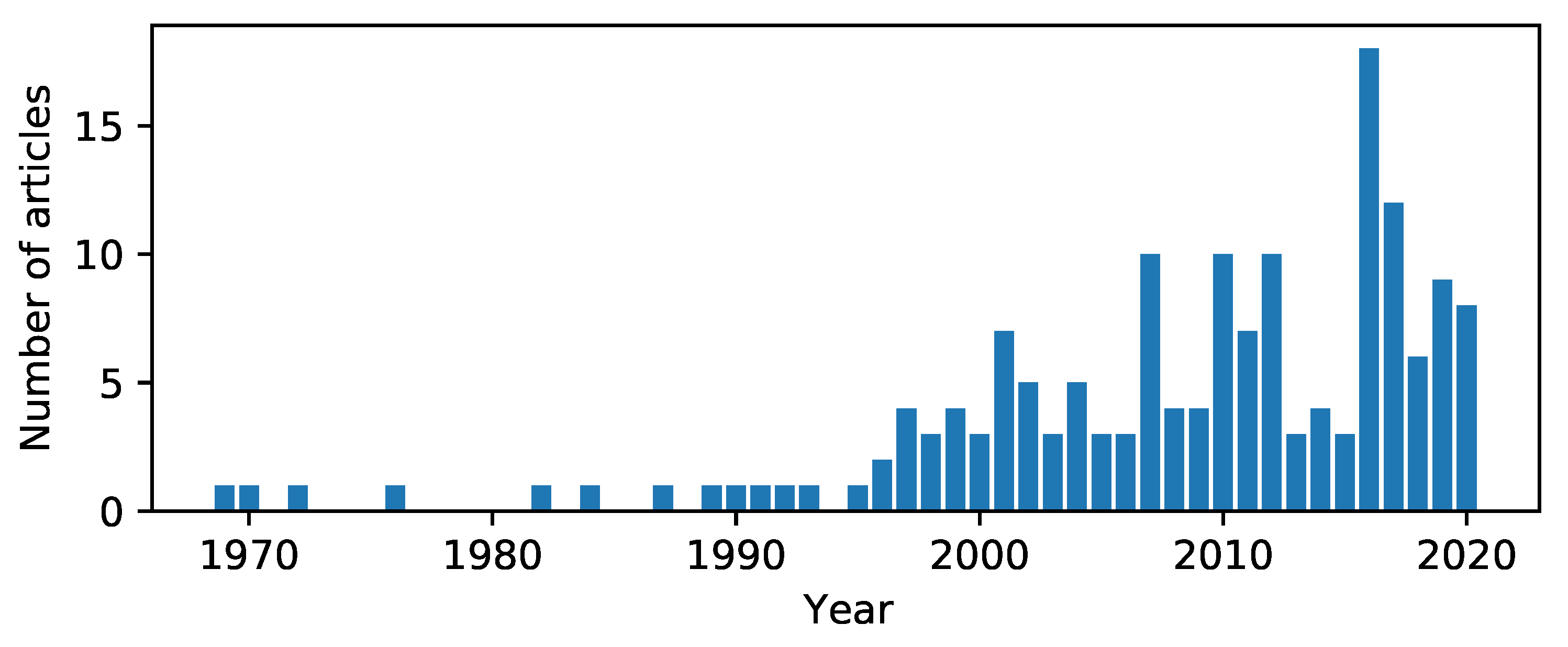


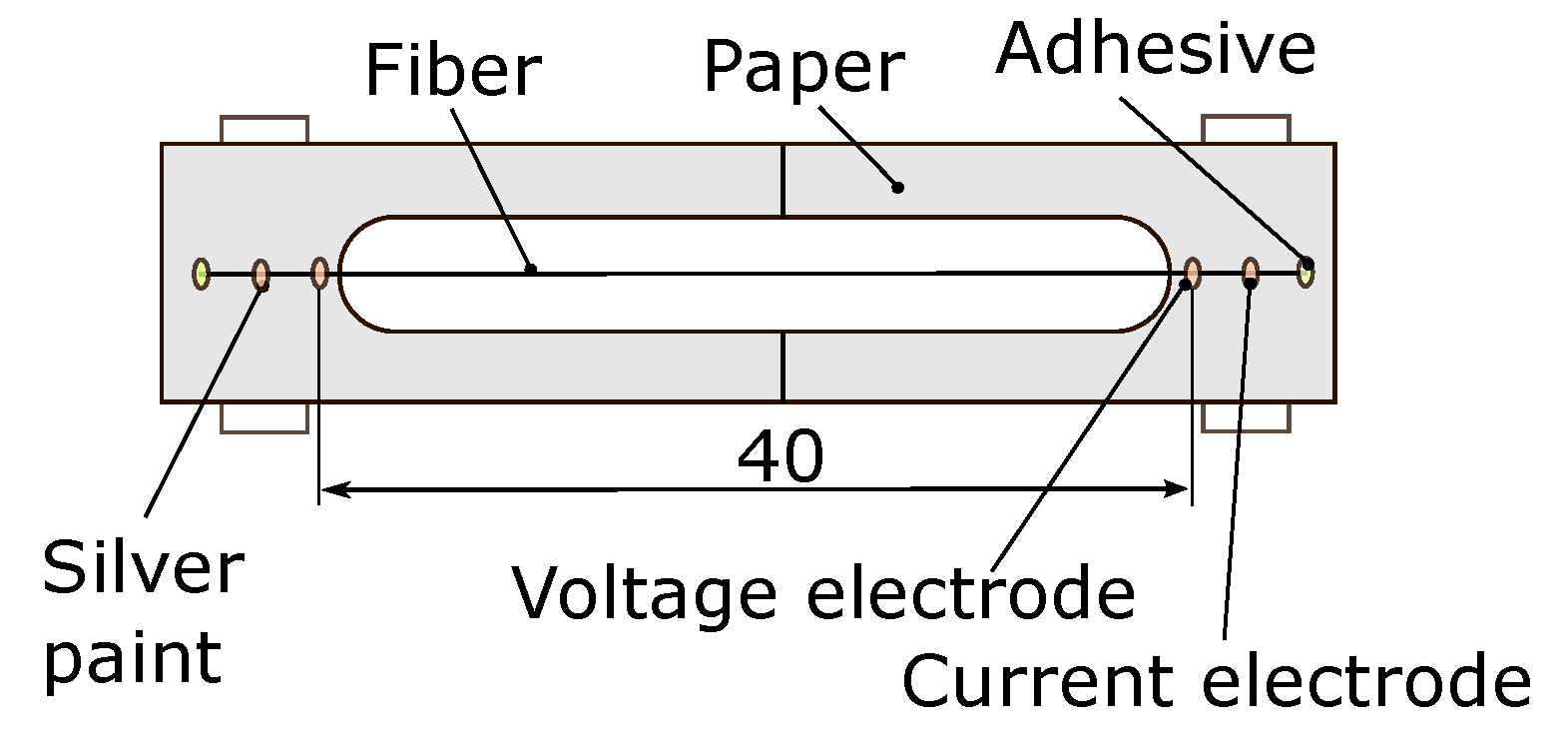
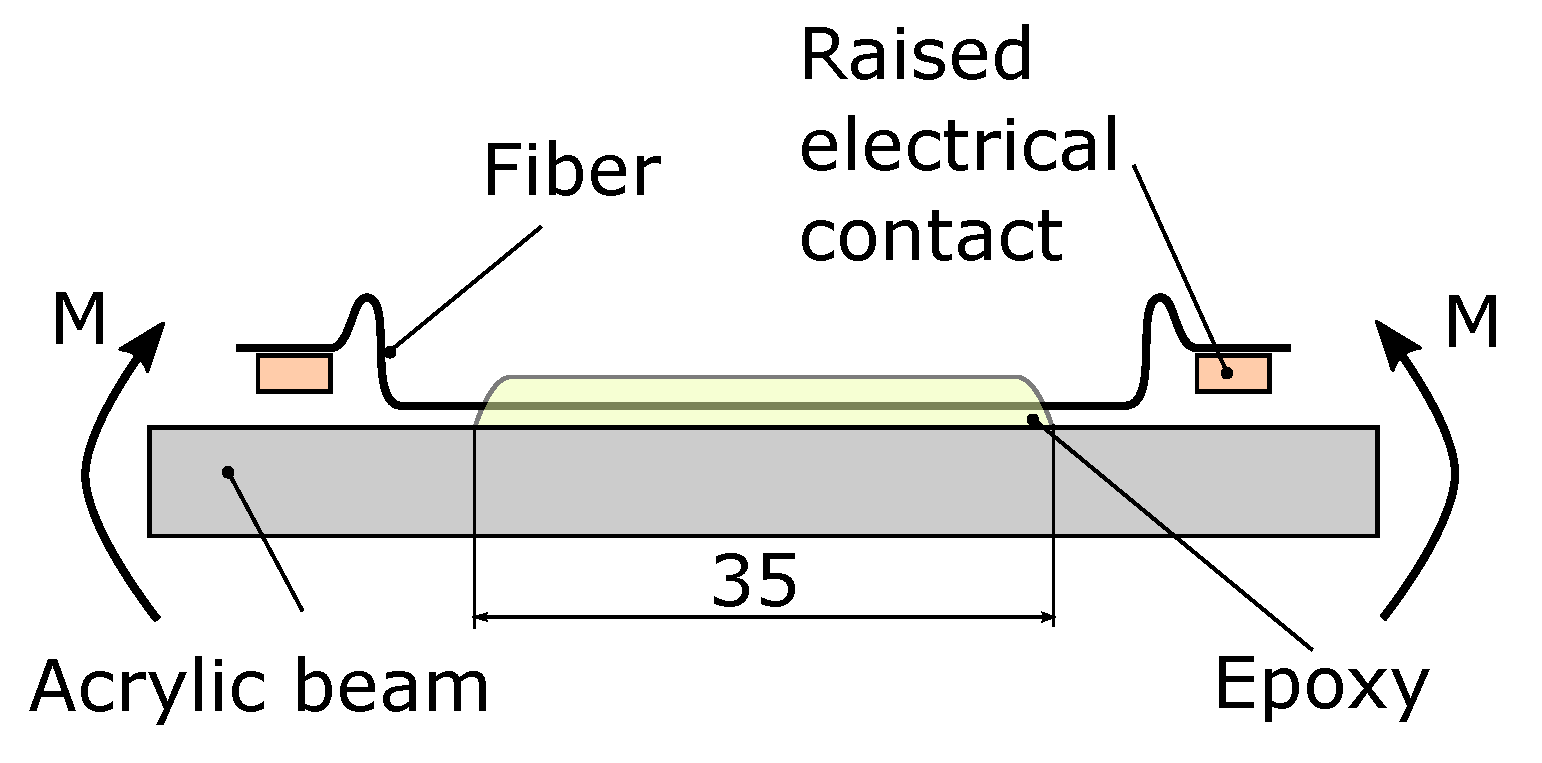


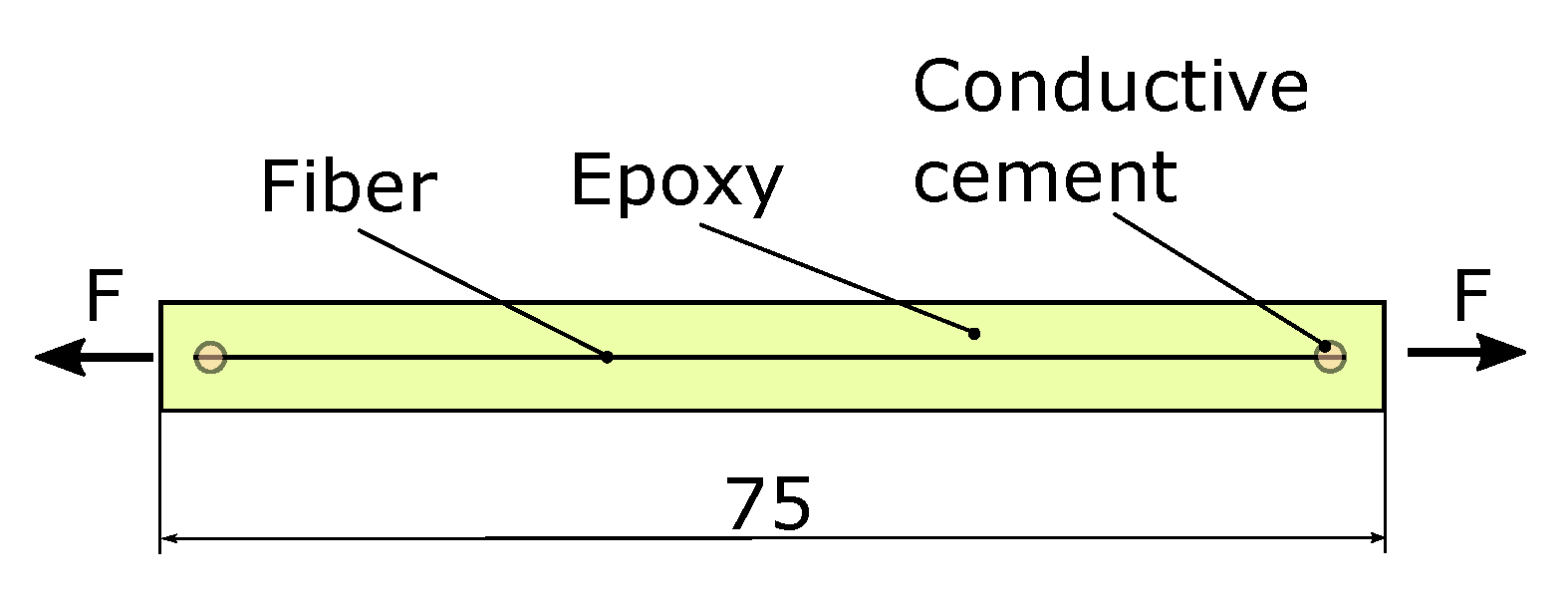

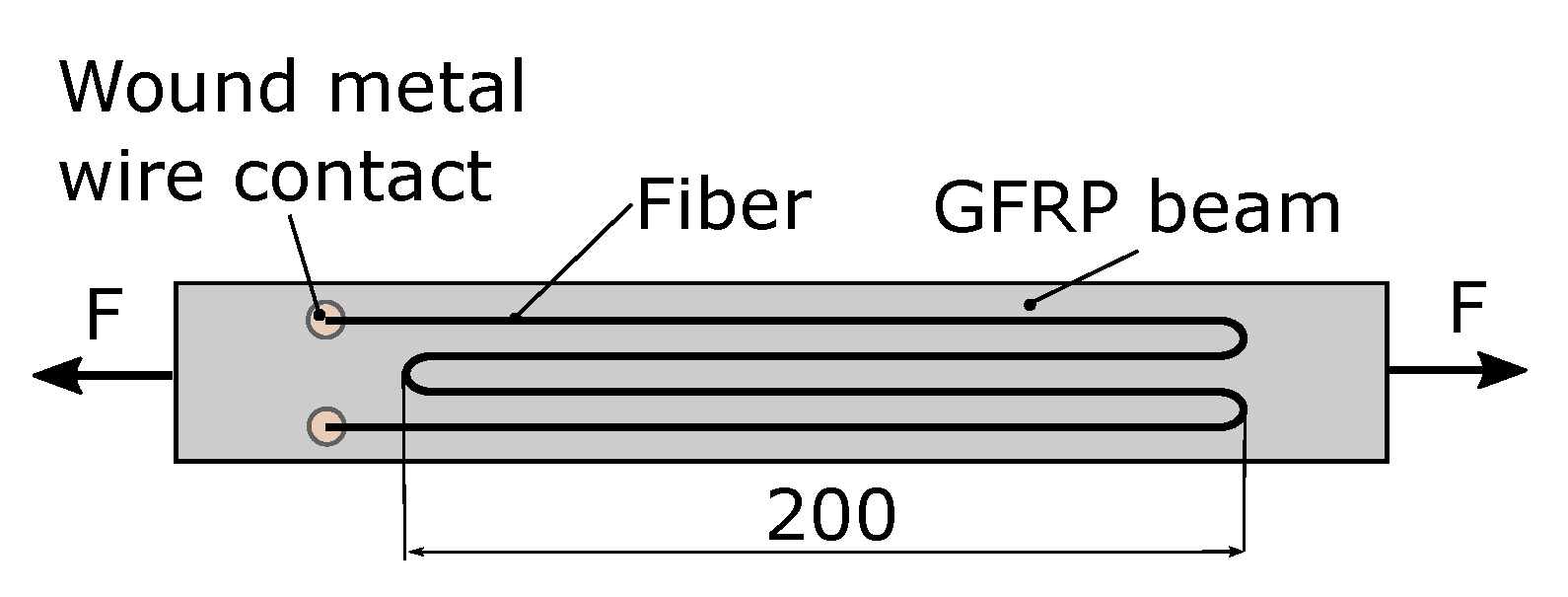

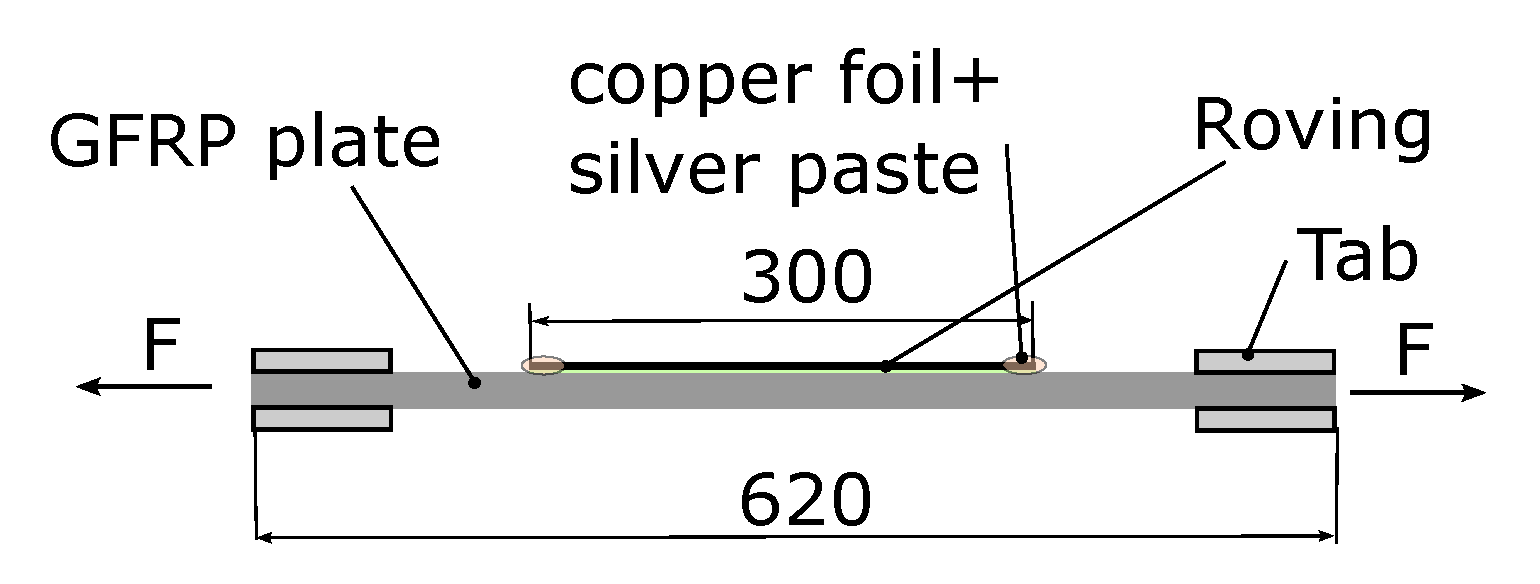
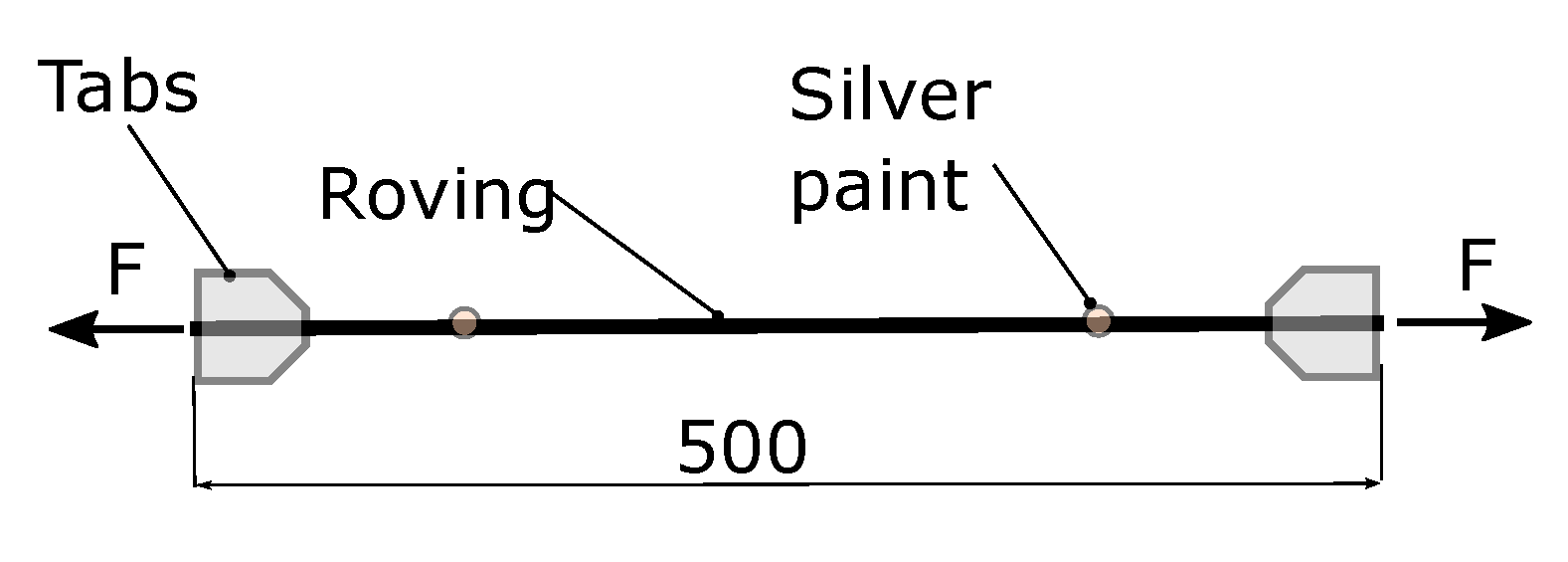

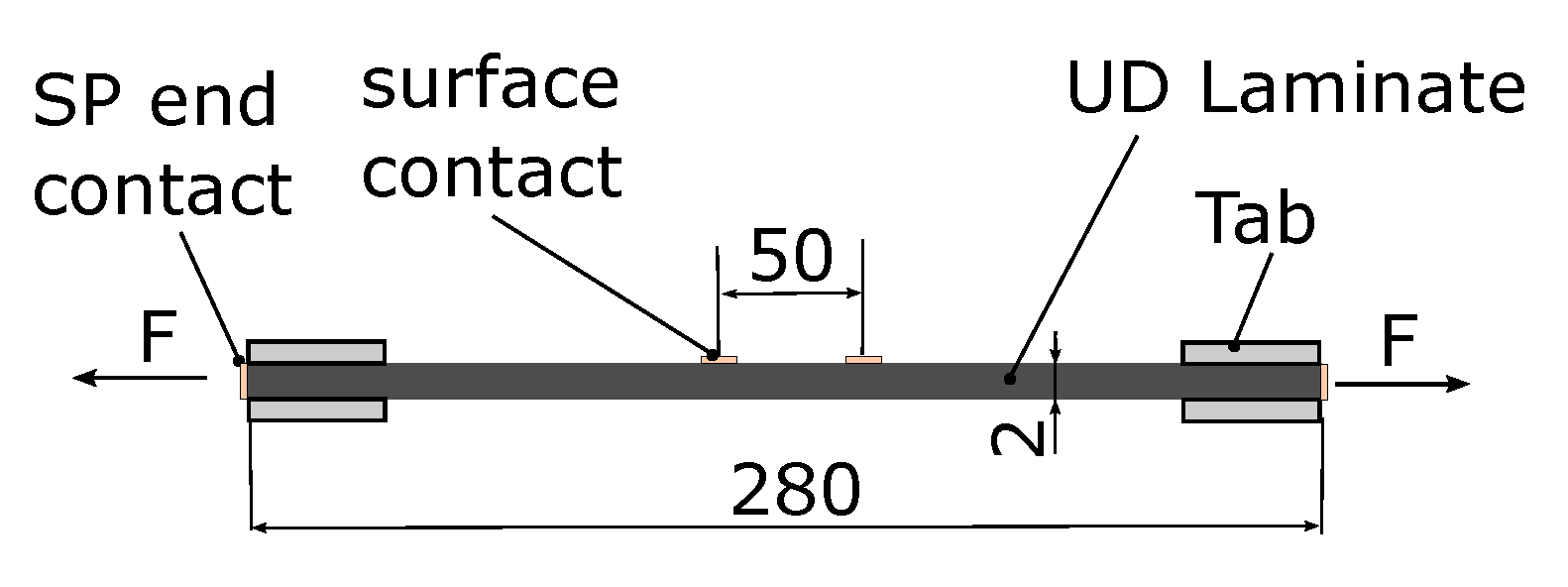
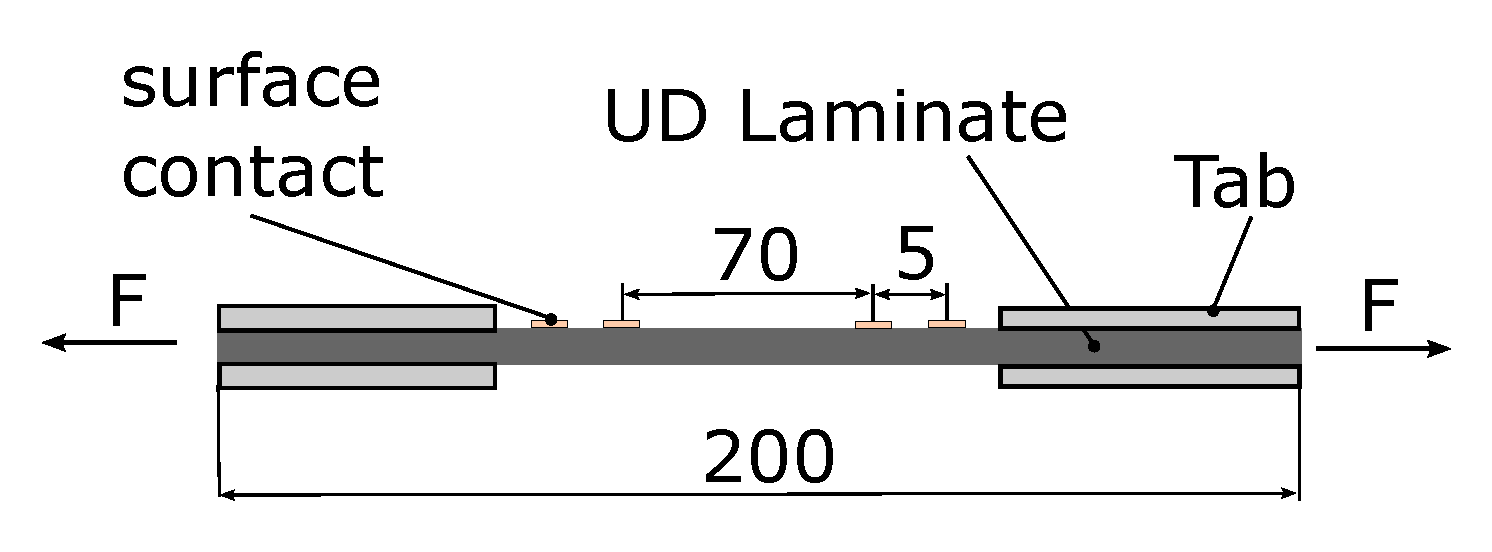

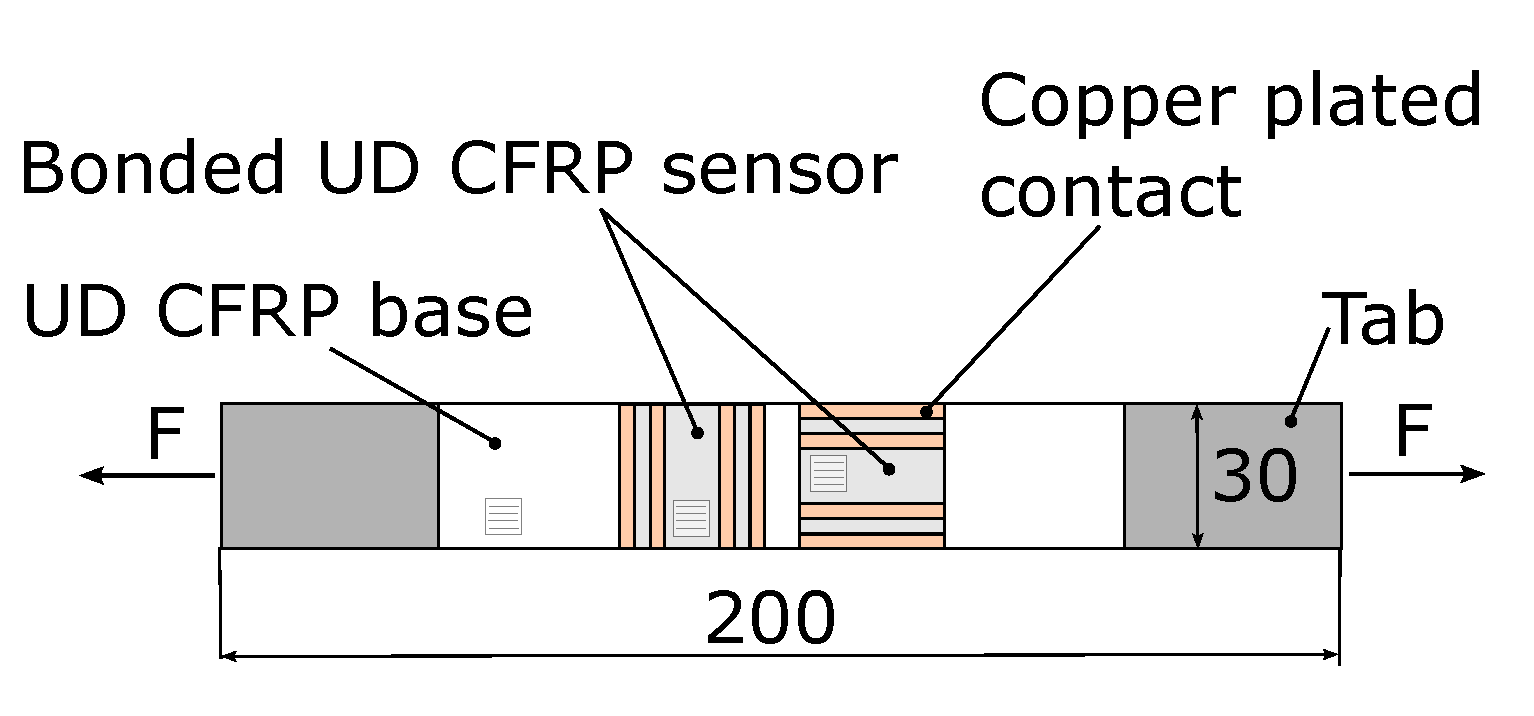

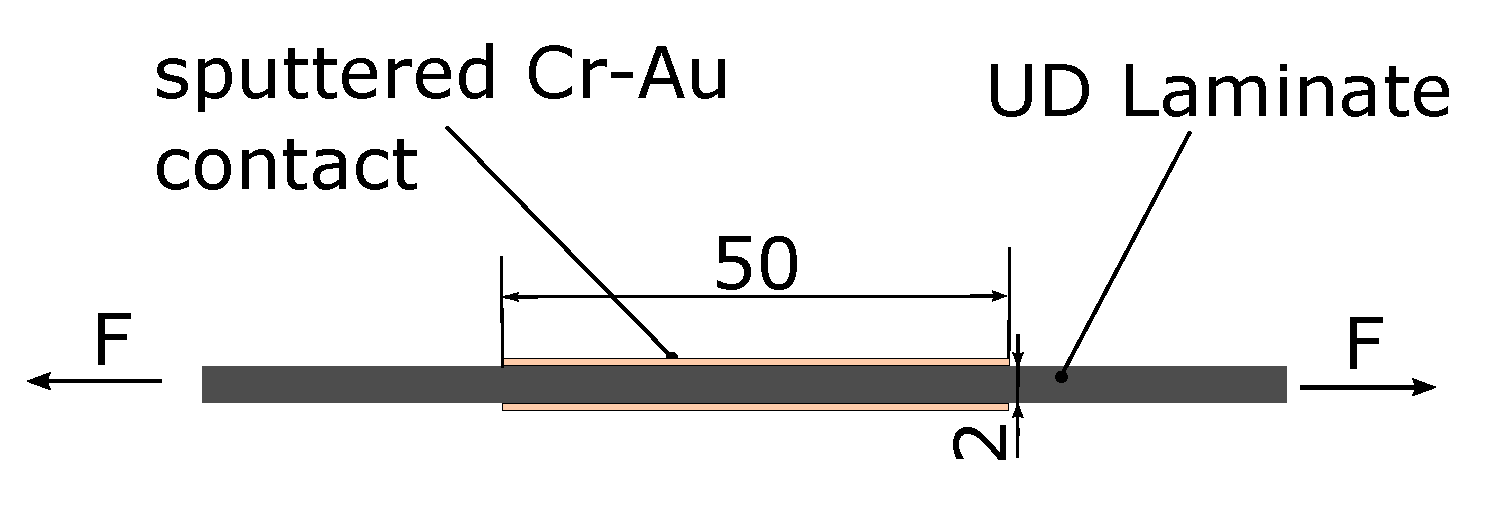

| Manufacturer | Fiber Name | E / GPa | Gauge Factor | Method | Source |
|---|---|---|---|---|---|
| undefined | 380 | 0.7 | 2-wire | [26] | |
| undefined | 340 | 1.3 | 2-wire | [26] | |
| undefined | 230 | 1.7 | 2-wire | [26] | |
| Whitaker | Type 2 | 330 | 0.6 | 2-wire | [27] |
| Celanese | ? | 786 | not reproducible | 2-wire | [27] |
| Toray | T1000 | 300 | 2.0 to 2.2 | 2-wire | [11] |
| Grafil | 33-500 | 230 | 2.0 to 2.2 | 2-wire | [11] |
| Hercules | AS4 | 230 | 2.0 to 2.2 | 2-wire | [11] |
| Amoco | T650-35 | 240 | 2.0 to 2.2 | 2-wire | [11] |
| Hercules | AS4 | 231 | 2.02 | 2-wire | [28] |
| Amoco | P-25 | 170 | 1.14 | 4-wire | [29] |
| Amoco | P-75 | 520 | 0 | 4-wire | [29] |
| Amoco | P-100s | 650 | −8.9 | 4-wire | [29] |
| Amoco | P-120 | 830 | −4.65 | 4-wire | [29] |
| Homemade | PAN 1400 | 200 | 1.26 | 4-wire | [29] |
| Homemade | PAN 2000 | 240 | 0.82 | 4-wire | [29] |
| Homemade | PAN 2300 | 270 | 0.68 | 4-wire | [29] |
| Homemade | PAN 2900 | 340 | −0.6 | 4-wire | [29] |
| Celanese | GY-80 | 640 | −3.87 | 4-wire | [29] |
| Amoco | P-75/CuCl2 | 273 | −1 | 4-wire | [29] |
| Amoco | P-75/MnCl2 | 347 | −3.1 | 4-wire | [29] |
| Amoco | P100s/MnCl2 | 337 | −7.3 | 4-wire | [29] |
| Toray | T300 | 221 | 1.8–2.3 | 4-wire | [30] |
| Toray | T700S | 230 | 5.1 | 2-wire | [31] |
| Toray | T800H | 294 | −2.2 | 2-wire | [32] |
| Toho Tenax | HTA5241 | 238 | 1.86 | 2-wire | [33] |
| Hexcel | IM7 | 250 | 4-wire | [34] | |
| Toho Tenax | HM35 | 345 | 1.77 | 2-wire | [35] |
| Toray | T700 | 230 | ? | [36] |
| Manufacturer | Fiber Name | E/GPa | Matrix | Method | Initial Gauge Factor | Source |
|---|---|---|---|---|---|---|
| Hercules | AS4 | 231 | Epoxy Epon 828 | 2-wire | 2.02 | [28] |
| Toray | T300 | 230 | Epoxy Epon 9405 | 4-wire | −17 | [39] |
| Toray | T800H | 294 | PVA | 4-wire | ≈−30 | [40] |
| Toray | T700 | 230 | Epoxy | 4-wire | 1.61 | [41] |
| Toho Tenax | HM 35 | 345 | LM E20/H20 | 2-wire | 0.42 | [35] |
| Toray | T700 | 230 | Polyimid | 4-wire | [36] | |
| Toray | M55j | 540 | Polyimid | 4-wire | [36] | |
| Nippon | XN90 | 860 | Polyimid | 4-wire | [36] |
Publisher’s Note: MDPI stays neutral with regard to jurisdictional claims in published maps and institutional affiliations. |
© 2021 by the authors. Licensee MDPI, Basel, Switzerland. This article is an open access article distributed under the terms and conditions of the Creative Commons Attribution (CC BY) license (https://creativecommons.org/licenses/by/4.0/).
Share and Cite
Scholle, P.; Sinapius, M. A Review on the Usage of Continuous Carbon Fibers for Piezoresistive Self Strain Sensing Fiber Reinforced Plastics. J. Compos. Sci. 2021, 5, 96. https://doi.org/10.3390/jcs5040096
Scholle P, Sinapius M. A Review on the Usage of Continuous Carbon Fibers for Piezoresistive Self Strain Sensing Fiber Reinforced Plastics. Journal of Composites Science. 2021; 5(4):96. https://doi.org/10.3390/jcs5040096
Chicago/Turabian StyleScholle, Patrick, and Michael Sinapius. 2021. "A Review on the Usage of Continuous Carbon Fibers for Piezoresistive Self Strain Sensing Fiber Reinforced Plastics" Journal of Composites Science 5, no. 4: 96. https://doi.org/10.3390/jcs5040096
APA StyleScholle, P., & Sinapius, M. (2021). A Review on the Usage of Continuous Carbon Fibers for Piezoresistive Self Strain Sensing Fiber Reinforced Plastics. Journal of Composites Science, 5(4), 96. https://doi.org/10.3390/jcs5040096








